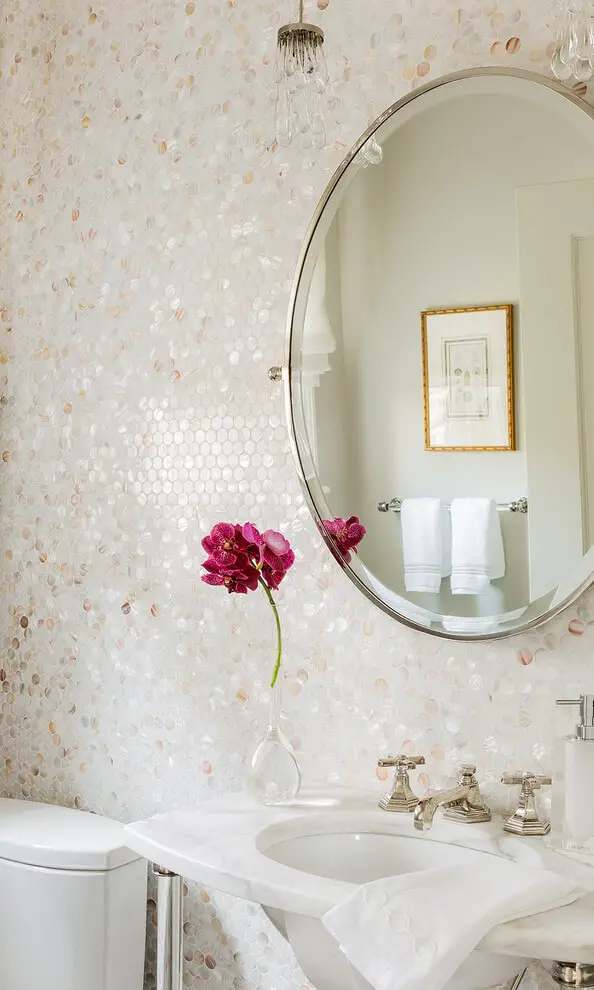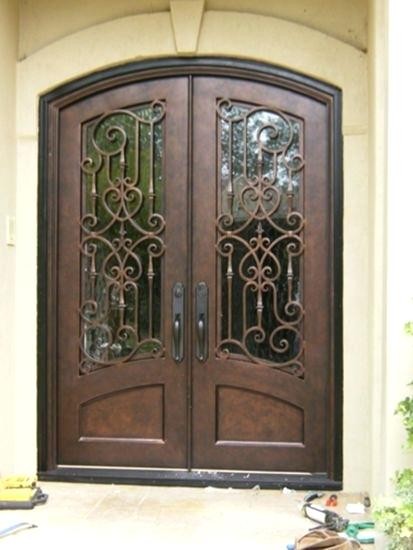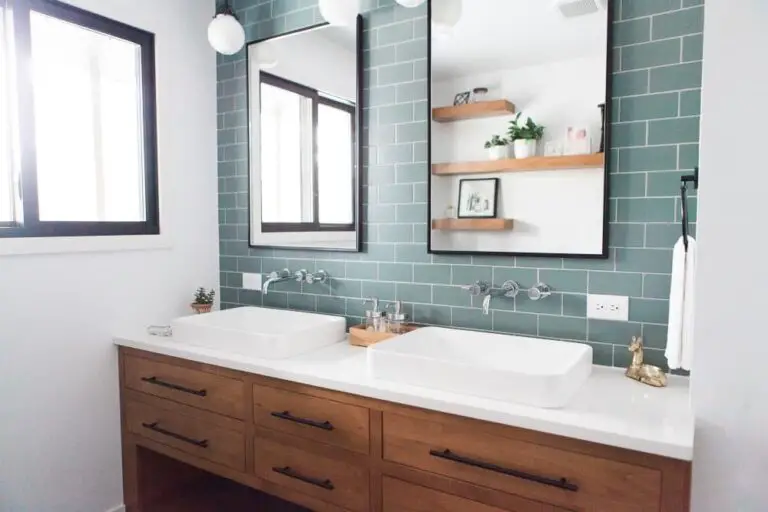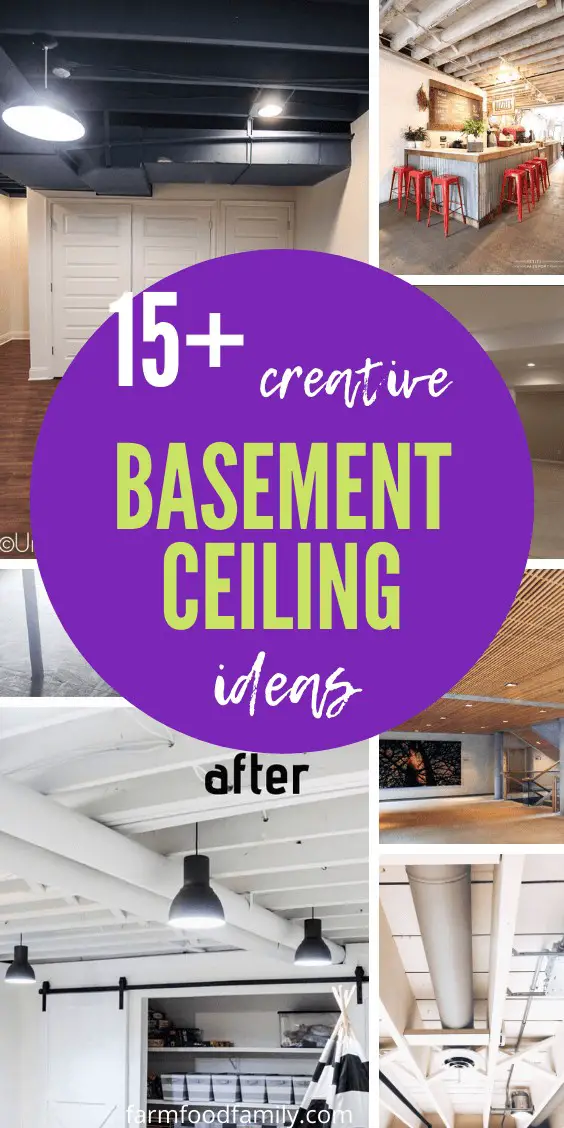68+ Creative And Cheap Garden Edging Ideas And Designs (2024)
Garden edging is a versatile feature that can enhance the functionality and aesthetic appeal of your outdoor space, extending beyond just the garden itself to impact the overall ambiance of your home. As you explore different design options, you’ll find that each has its unique purpose and application. With so many choices available, selecting the perfect one may seem daunting, but starting with a clear idea is key.
This article will provide valuable insights into various garden edging ideas, helping you to make informed decisions for your project.
What is garden edging?


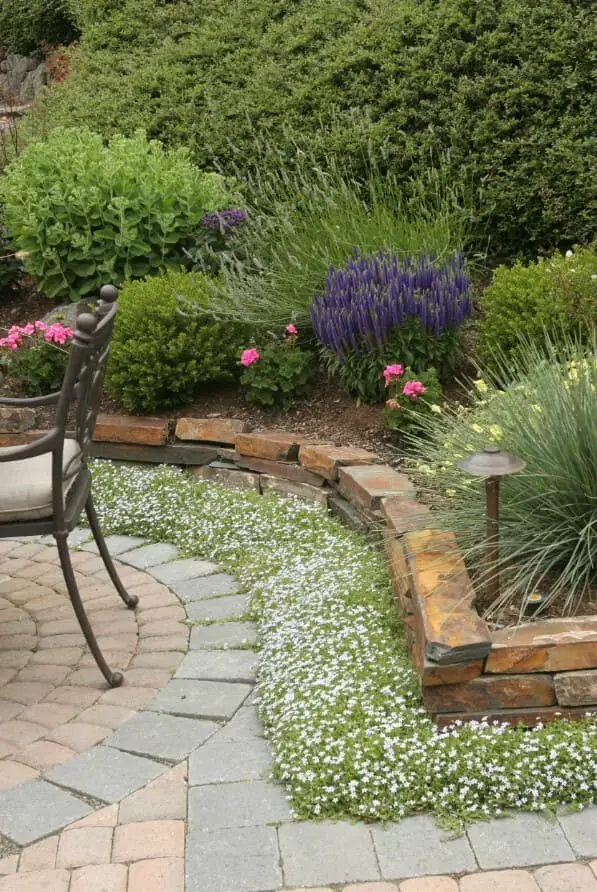
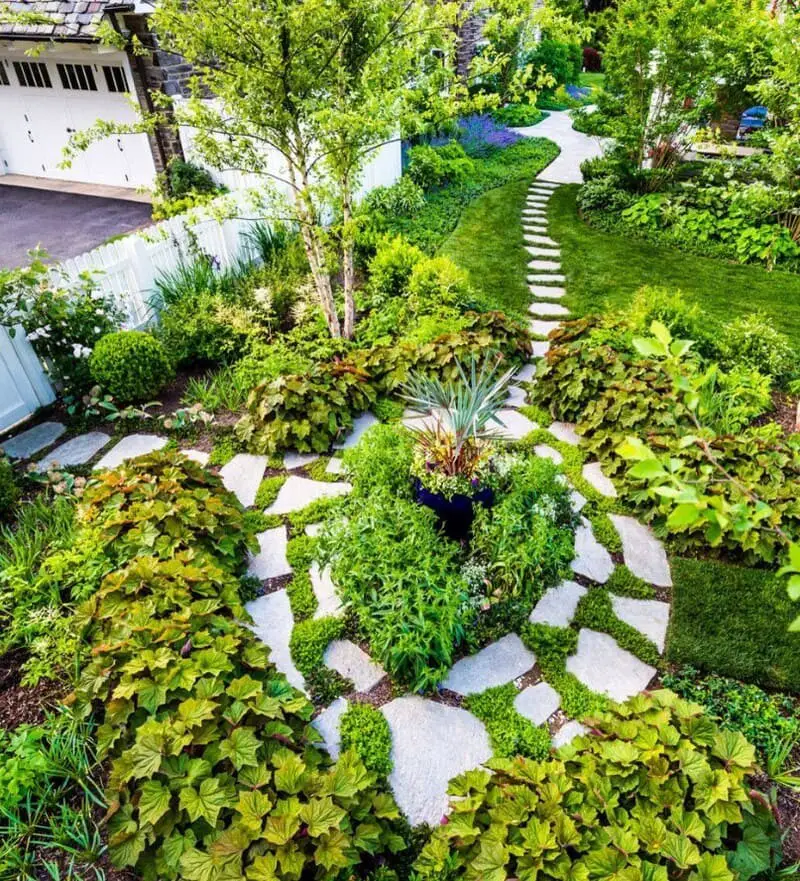
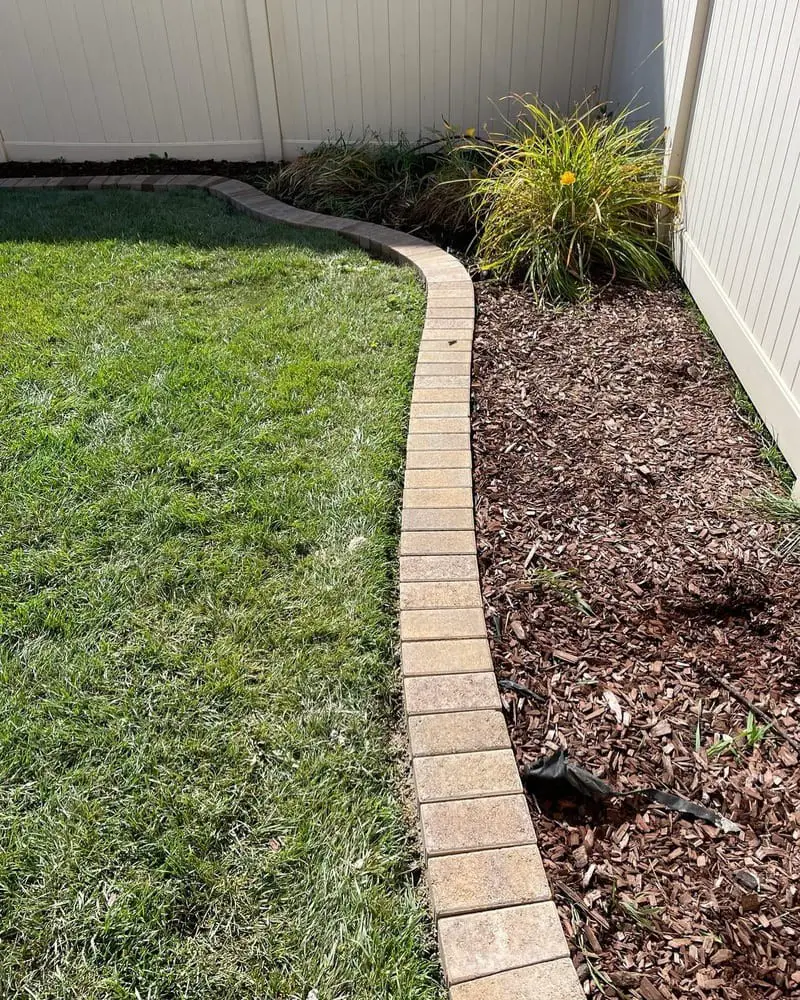
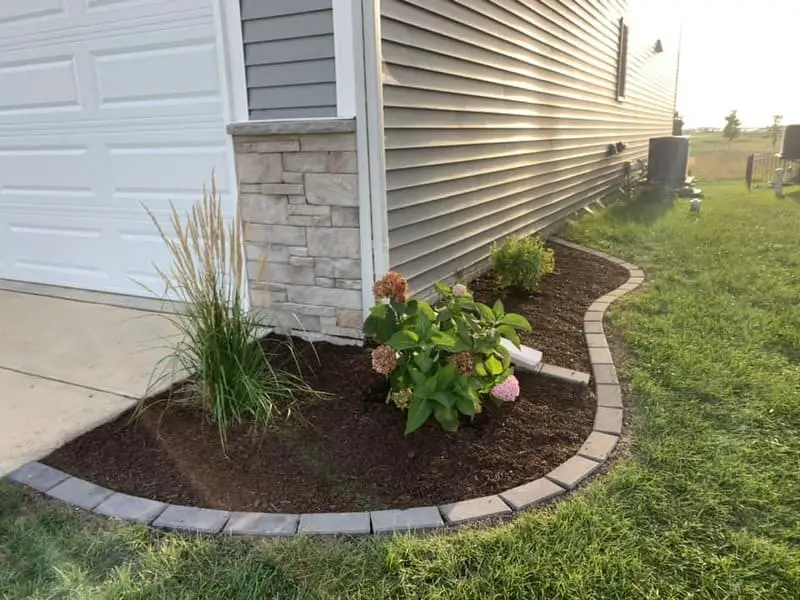
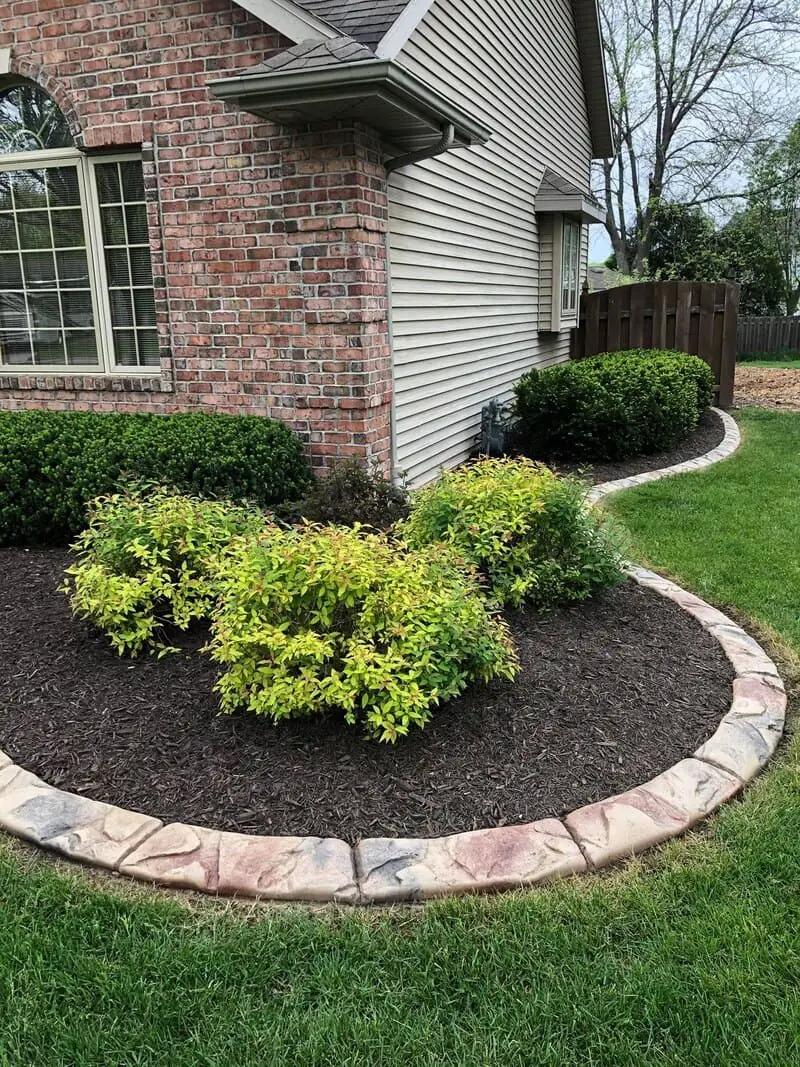





Mastering garden edging requires an understanding of its dual nature: as both a creative activity and a practical solution for maintaining your outdoor space. This artful craft involves accentuating various sections within a single garden area, serving two primary purposes: to highlight distinct features and prevent grass from overgrowing prized plants. For instance, you might have a backyard greenhouse, raised vegetable bed, cobblestone pathway, flower beds, or even a table setting.
To create harmony among these elements, each section must be treated as if it were the centerpiece, ensuring a cohesive look that makes sense within the larger garden design. While aesthetics play a crucial role in garden edging, this process is more than just beautifying – its practical applications will be explored further on.
Why use garden edging?
Garden edging plays a multifaceted role in maintaining the overall aesthetic and functionality of your outdoor space. At its core, it serves as a retaining wall for mulch, keeping it in place even when rainfall is heavy. This ensures that your carefully tended garden beds remain well-defined and free from erosion.
In addition to its practical applications, garden edging also acts as a protective barrier between your lawn mower and sensitive plant life.
By installing edging, you can prevent accidental damage to your flowers, shrubs, and trees.
Furthermore, garden edging offers the ability to create visual distinctions between different areas of your garden, such as separating fruit-bearing plants from flowering ones or transitioning seamlessly from a patio to a lush green space. Overall, incorporating garden edging into your landscaping design can help achieve a tidy, organized look that enhances the overall appeal of your outdoor oasis.
Where to place garden edging?
When it comes to determining the placement of garden edging, there isn’t a single definitive answer. However, in general, it’s most commonly used to accentuate and protect raised flower beds in the middle of the garden, as well as along the boundaries of fences that surround trees, ornamental plants, and additional flowers. It can also be used to define pathways within the garden.
Ultimately, where you place your garden edging is up to personal preference and depends on how you envision your outdoor space. There are numerous approaches you can take to plan out its placement, allowing for endless possibilities.
How to install garden edging
When it comes to garden design, the subtle details can often make a significant impact on the overall aesthetic. Garden edging is one such element that, if done correctly, can elevate your outdoor space from ordinary to extraordinary. However, if not executed properly, it can have the opposite effect – creating visual dissonance and disrupting the harmony of your garden. To avoid this common pitfall, it’s essential to understand the basics of installing garden edging.
In this piece, we’ll explore the key principles and techniques that will help you get it right.
Location
When it comes to adding garden edging, the first crucial step is to identify the specific area in your outdoor space that requires definition. This could be where two distinct features, such as gravel and mulch, meet, or perhaps where different types of grass are growing together. Additionally, areas with loose elements like rocks, stones, and pathways can greatly benefit from the addition of edging, helping to create a more cohesive and visually appealing landscape.
Edging type
When selecting the perfect spot for your garden bed, it’s essential to consider the type of edging that will best complement your design. The majority of variants fall under the category of solid edging types, which include wood, metal, concrete, rubber, and plastic. For rustic designs, wood edging is often a natural fit, while metal or concrete edging can create a sleek, contemporary look.
On the other hand, ornamental gardens and vegetable beds may benefit from the modern appeal of rubber or plastic edging. If you’re looking for something more unique, individual edging types featuring pebbles or stone pavers are also worth considering, providing a departure from traditional solid edging options.
Trench
With all preparations complete, it’s time to start digging the trench. While there’s no one-size-fits-all depth requirement, it’s crucial to calculate a suitable depth that balances safety and aesthetics. If the trench is too shallow, it may collapse or become unstable, while going too deep can create a tripping hazard or visual eyesore in your garden.
To achieve the perfect balance, aim for a top level slightly higher than your lawn and its groundcover, but not so tall that it disrupts the overall flow of your outdoor space.
Install edging
When it comes to installing your raised garden bed, there’s a crucial step to keep in mind. To achieve a seamless and even finish, ensure that any gaps between components are minimized and leveled accordingly. If you encounter issues with these gaps, consider utilizing interlocking landscape elements to create tighter fits. Additionally, employing an edging tool early on in the installation process can help prevent unwanted slopes and ensure a smooth, consistent result.
Secure the edging if necessary
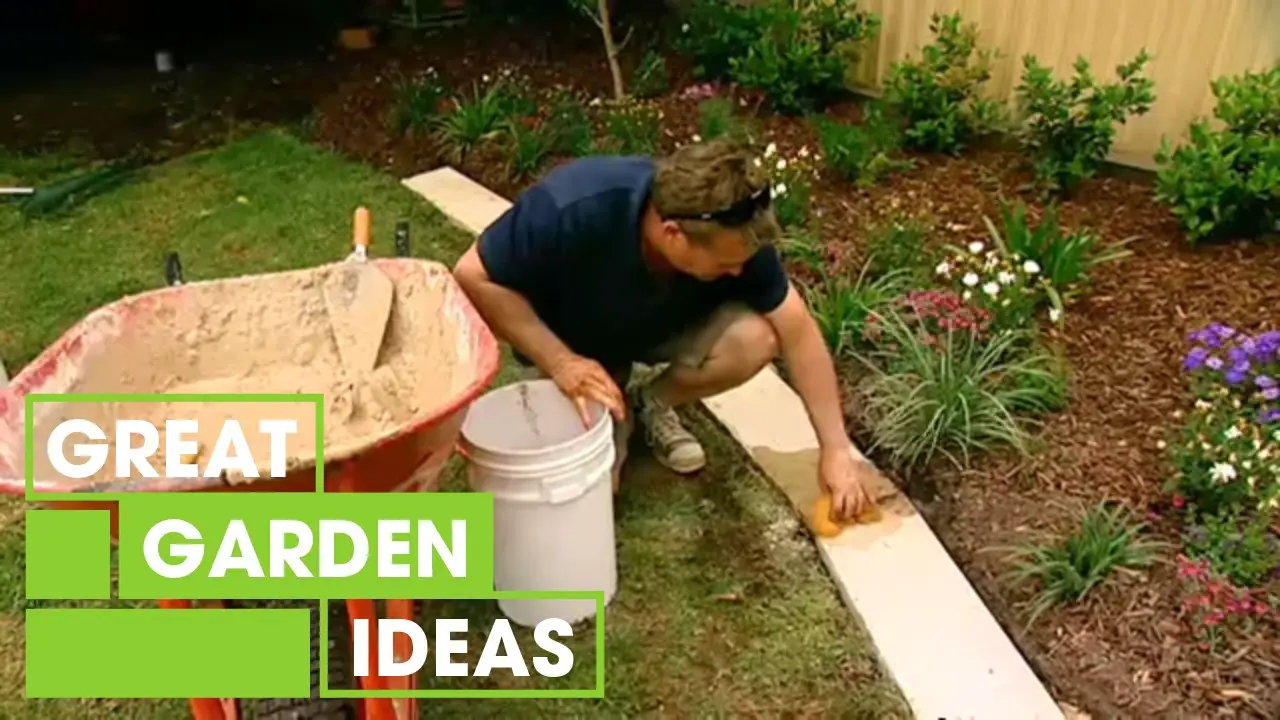
When it comes to installing edging materials like brick, metal, or stone, some may be more robust than others. However, when it comes to rubber and plastic edgings, they require a bit more attention to ensure they remain secure. One effective way to achieve this is by using wood or metal stakes to anchor them in place. Additionally, applying a groundcover on top of the edging can provide an extra layer of protection against potential damage.
For those who prefer a visual guide, there are several online resources available, including videos from reputable sources such as Great Garden Ideas, Multy Home, and Bunnings.
68+ Inexpensive Garden edging ideas

As we approach the climax of our exploration of garden edging ideas, it’s essential to acknowledge that narrowing down the options can be a daunting task without a solid foundation. To facilitate this decision-making process, let’s take a closer look at some of the most popular and user-friendly edging solutions available. From here, you’ll be well-equipped to make an informed choice that suits your unique gardening style.
Brick garden edging ideas


When it comes to defining boundaries for flower beds, bricks are a top-notch choice. They evoke a charming rustic charm reminiscent of England’s countryside and quaint cottages. But beyond their aesthetic appeal, bricks also boast a rich history as a fundamental component in architecture and design, often paired with mortar as its trusted adhesive companion. This union creates a sturdy and long-lasting edging solution that can withstand the test of time.
If you’re looking to incorporate bricks into your garden design, here are some inspiring ideas to get you started.
Flower Bed edging ideas
When unwanted growth becomes a persistent issue in your lawn, it’s essential to implement a solution that prevents these interlopers from taking over. One effective approach is to install a flower bed edging, which not only keeps grass and weeds at bay but also defines the boundaries between your lawn and plantings. To explore more natural methods for controlling weeds without harming your grass, visit this link:
Lawn edging ideas
The front yard’s lawn is often the crowning glory of any home. However, when grass grows too long, it can quickly become a nuisance, leaving driveways slippery and sidewalks messy. As this space plays a significant role in defining one’s property identity, it’s essential to consider innovative lawn edging ideas. Like the various options available for cultivating lawns – from seed-grown grass to artificial turf or sod-based alternatives – there’s an array of lawn edgings to choose from.
For those seeking inspiration, I’ve explored budget-friendly driveway ideas in a previous post.
Stone garden edging
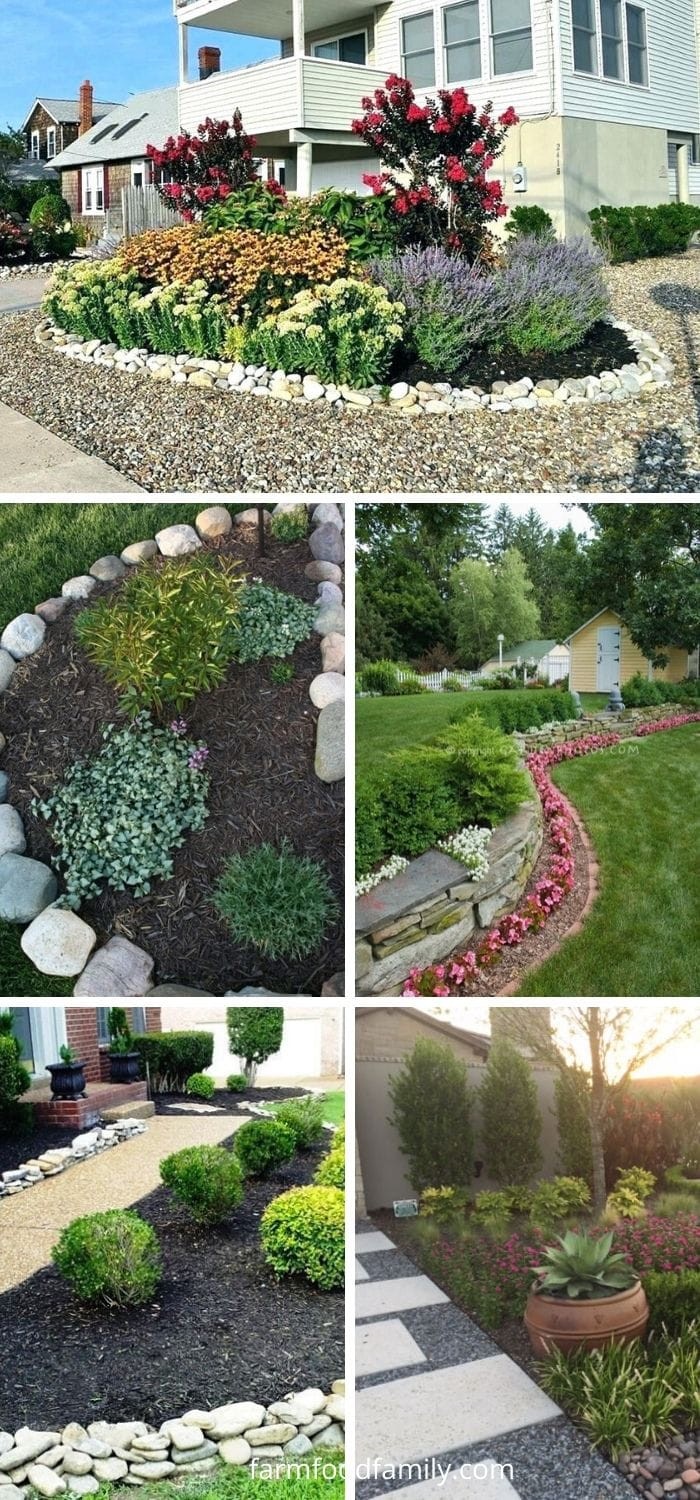
When it comes to installing stone garden edgings, two stone types are typically combined. Unlike certain stones that can hold their own, such as cobblestones and flagstones, a stone garden edge provides a subtle yet effective way to highlight ornamental features, trees, and flowers while separating them from the surrounding grass in both lawns and backyards. This combination of stones serves to add a touch of elegance and definition to your outdoor space.
Metal garden edging
While metal garden edging offers an affordable solution, its durability is also noteworthy when properly maintained – it can last up to two decades. With a few options to consider, aluminum and steel are the most common materials used in this category. Notably, steel outperforms aluminum as the better choice. To get you started, here’s a selection of metal gardening edging ideas.
Concrete garden edging
Concrete garden edging offers a budget-friendly yet visually appealing solution that serves both aesthetic and practical purposes. One of its greatest advantages is its customizability – through etching, you can infuse your chosen design before the concrete solidifies, making it a unique feature in your outdoor space. Additionally, this material is remarkably low-maintenance; as it doesn’t require securing, you can rest assured that it will remain in place for a long time to come.
To further illustrate its durability and versatility, here are some ideas to get you started.
Plastic garden edging
While plastic edging may not be the most durable option for your garden, its affordability makes it an attractive choice for many homeowners. With proper maintenance, plastic edging can withstand the elements and pesky critters, making it a practical solution for those on a budget. Additionally, the DIY-friendly installation process allows you to take matters into your own hands, saving time and money.
When installed correctly, plastic edging can provide a tidy finish to your garden beds and borders, all without breaking the bank.
Rubber garden edging
Rubber material offers a cost-effective alternative to metal and plastic, with a wide range of colors and shapes available. Its versatility lies in its ability to mimic the appearance of more expensive materials like brick and concrete, making it a popular substitute in many design applications. While it may not be suitable for large-scale or elaborate designs, rubber is ideal for smaller ornamental pieces and minimalist creations where a subtle, understated look is desired.
Wood garden edging
Wood’s timeless appeal stems from its organic nature, versatility, and earthy charm. Unlike synthetic materials, wood allows for customization, making it a perfect fit for those seeking a personalized touch. Moreover, wooden gardens are remarkably low-maintenance and can last for generations if properly cared for. Take a look at these designs to see the beauty of wood in action.
Decorative garden edging
With unlimited possibilities, it’s tempting to get carried away and come up with countless design concepts. The beauty lies in the fact that you have complete creative freedom to tailor each idea to your unique vision.
Border fencing

While the term ‘border fencing’ may evoke images of physical barriers, it can also refer to the creative process of defining boundaries within a garden or outdoor space. This can involve separating distinct areas, such as different garden beds or landscaping features, or even distinguishing between various plant species. The possibilities are endless, and the design aesthetic can range from ornate Victorian woodwork to rustic concrete accents.
Bamboo garden edging
Looking to bring a touch of tranquility to your outdoor space? Bamboo garden edging is an excellent choice, offering a harmonious blend of nature and design. Not only is bamboo readily available and relatively affordable, but it’s also easy to incorporate into your own DIY project. For inspiration, consider the creative ideas presented by lagringasblogicito, Bamboo Grove, or Master Garden, all of which showcase the versatility of this natural material.
River rock edging
River rocks offer the unique advantage of being accessible at no cost, provided you can identify the ideal sizes and color combinations that suit your design aesthetic. When incorporated into your landscape, they can add a charming touch. However, it’s essential to have a reliable adhesive on hand to ensure the rocks remain in place and retain their intended visual impact.
No dig garden edging
For those who may feel uncertain about digging trenches, an alternative lies in the realm of no-dig gardening solutions using rubber and plastic materials for edging. Drawing inspiration from innovative gardeners and Main Street Lawn, here are some ideas to get you started.
Curved garden edging
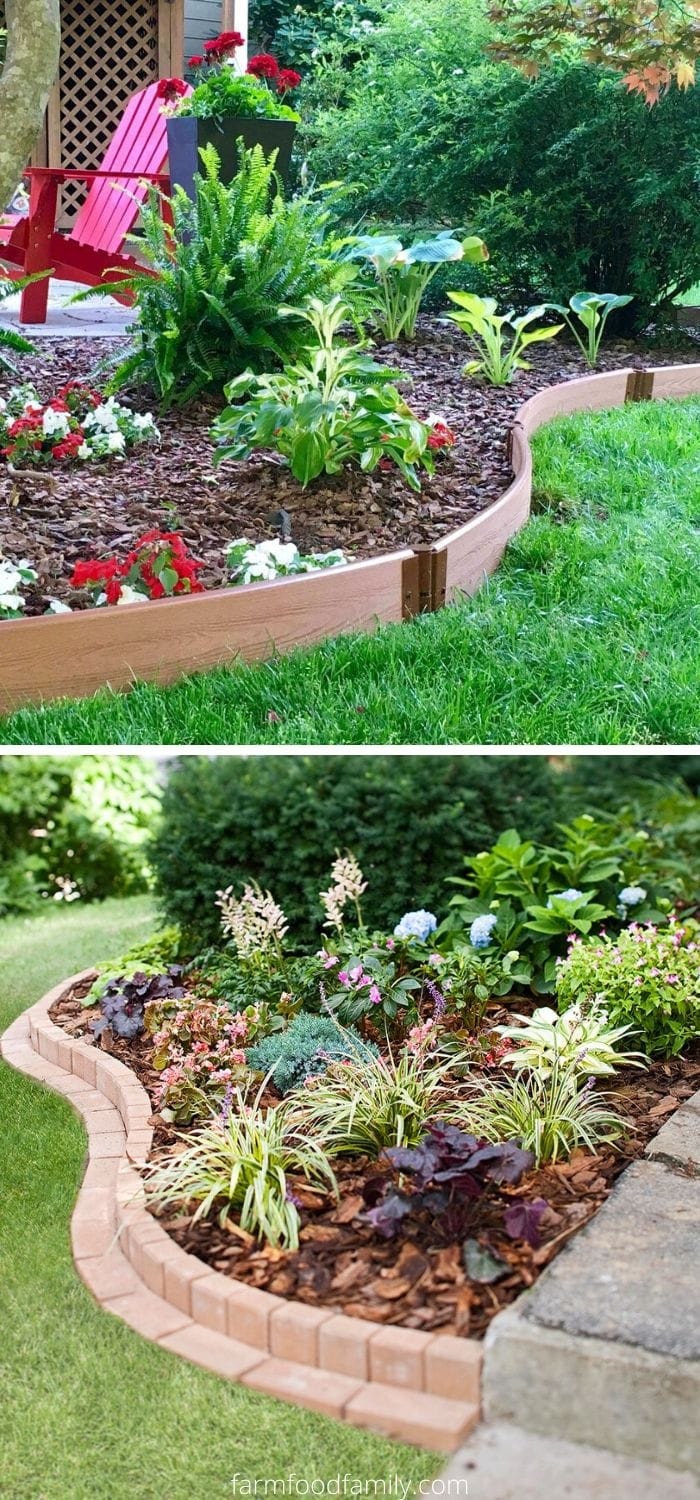
When it comes to accentuating the natural curves and expansive feel of a yard, curved edging can be a fantastic design choice. This technique is often used to highlight the unique shape and grandeur of garden and yard corners, particularly when featuring ornamental plants or majestic trees like those showcased by reputable sources such as Better Homes and Gardens (BHG) and experienced gardening professionals.
Vegetable garden edging
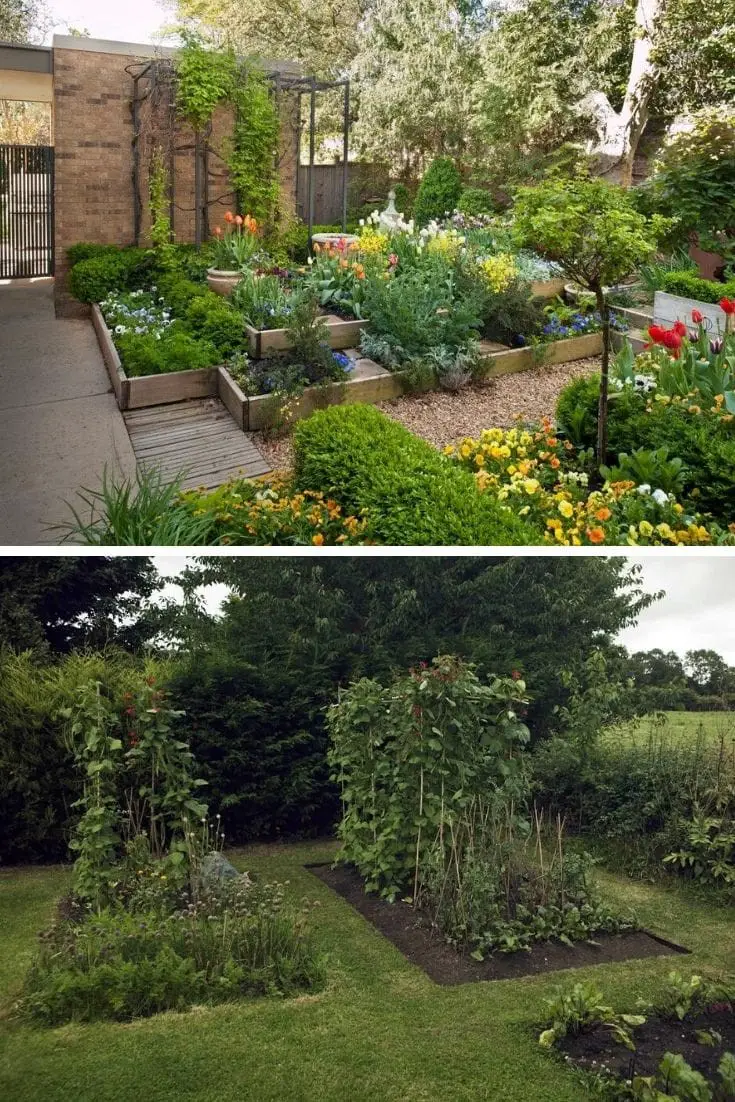
When it comes to creating a visually appealing vegetable garden, one key element is often overlooked: edging. Rather than using harsh materials like concrete or metal, many gardeners opt for the timeless charm of wood. While there’s no denying the functionality of these options, wooden garden edges can add a warm, inviting touch to your outdoor space.
To get started, consider the following ideas from Gardenista, which offer a wealth of inspiration and guidance on incorporating wood into your vegetable garden design.
Wire garden edging
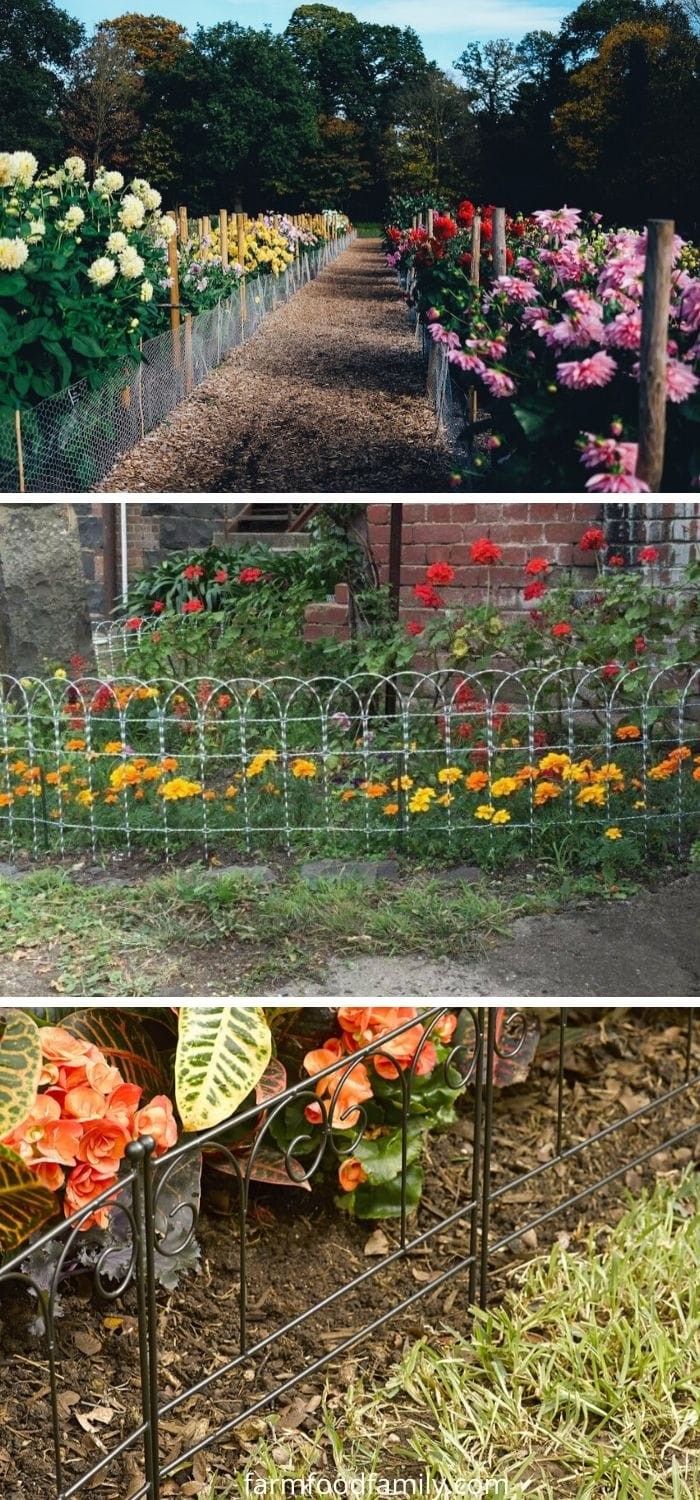
While hard metal wires offer their own unique benefits, you also have the option to work with more pliable options. The fact remains that these adaptable wires can be just as versatile and impactful as any of the other materials highlighted in this piece. Some inspiration for your projects can be found in the innovative designs and approaches showcased by Gum Tree.
Gravel edging
When it comes to back-to-basics design, one of the most versatile and accessible materials is gravel. Not only is it an affordable option, but it also requires minimal preparation to create a unique raised edge feature. To get started, simply arrange the gravel in a visually appealing pattern and secure it with a reliable adhesive. Here are some inspiring ideas to consider:
Path edging
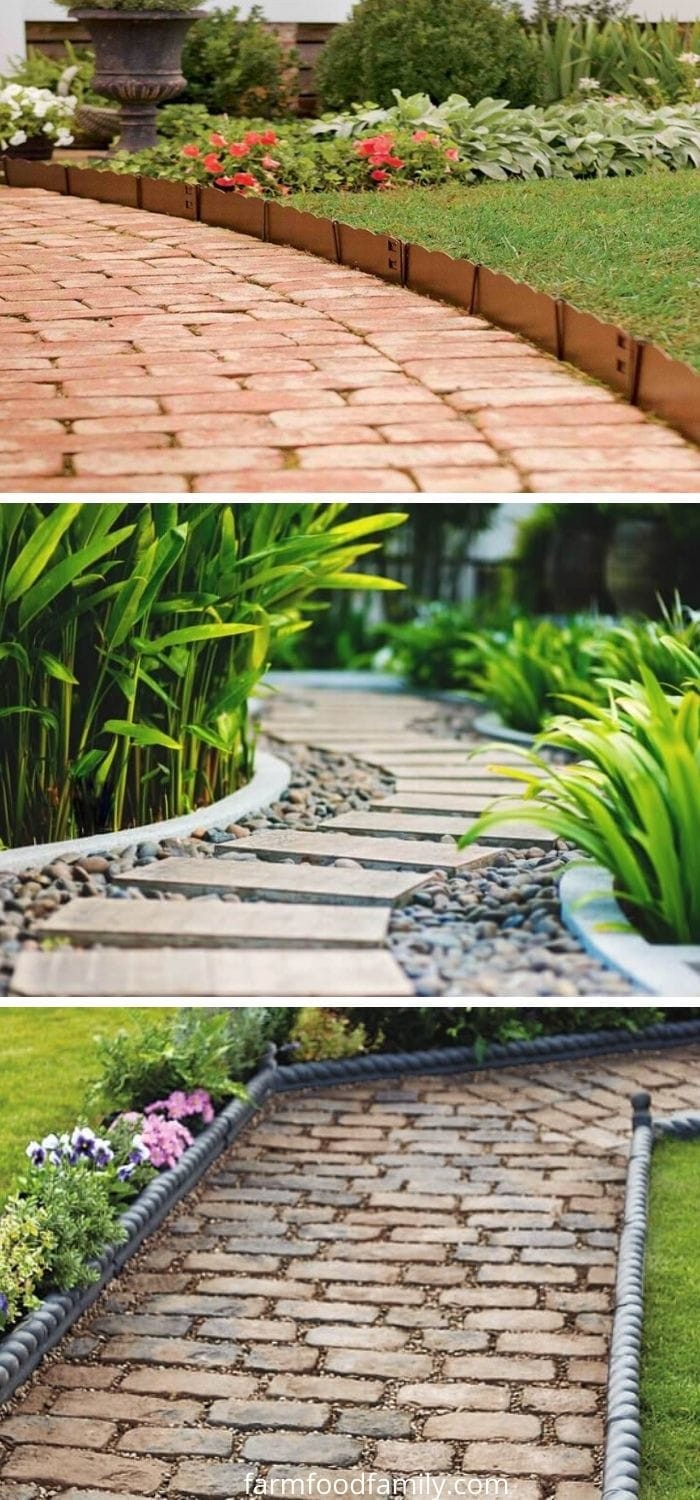
A key objective is to create an intuitive route that guides visitors through various landscapes, including lush vegetation and scenic vistas. This path can be straightforward or take a dramatic turn, much like the examples mentioned earlier.
Slate garden edging
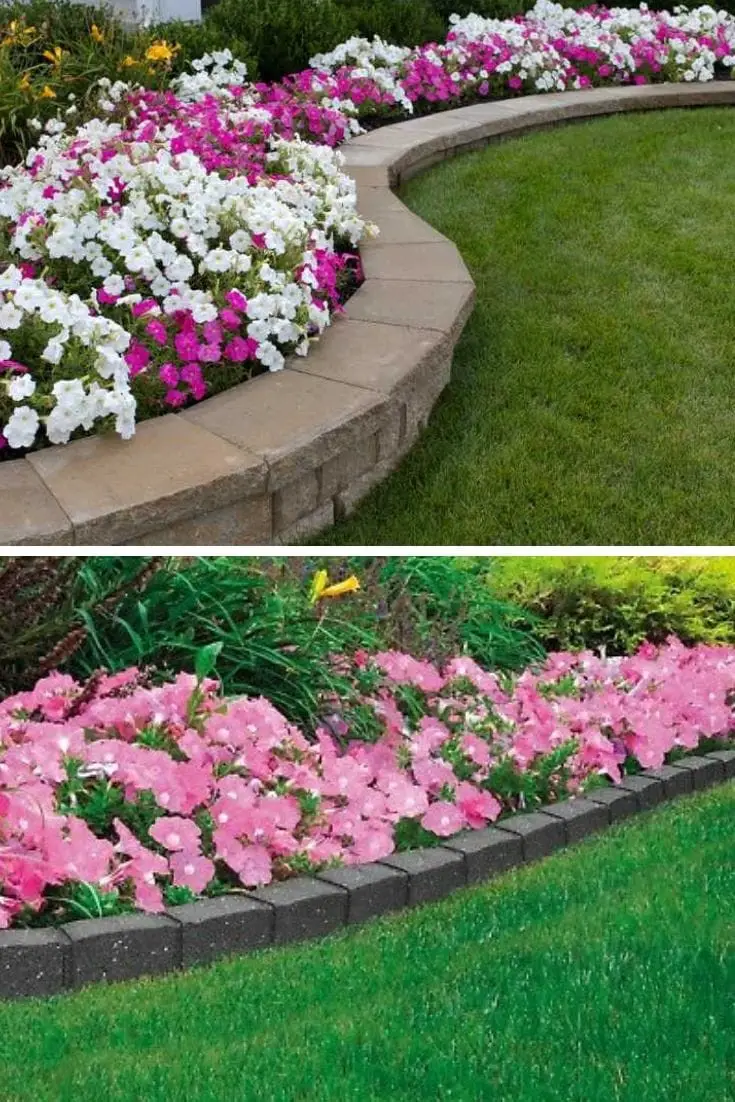
Slate garden edging, either stamped or stained, embodies a timeless charm. While cobblestone and flagstone options may have their appeal, large, polished slabs create a truly unique visual statement.
Japanese garden edging

While bamboo edging is a popular choice, the Oriental-inspired design offers a unique blend of multiple landscape elements. This style combines different textures and materials such as concrete and stone, slates and wood, or even metal and glass, creating a visually appealing and harmonious whole. Here are some creative ideas to draw inspiration from:
Recycled garden edging
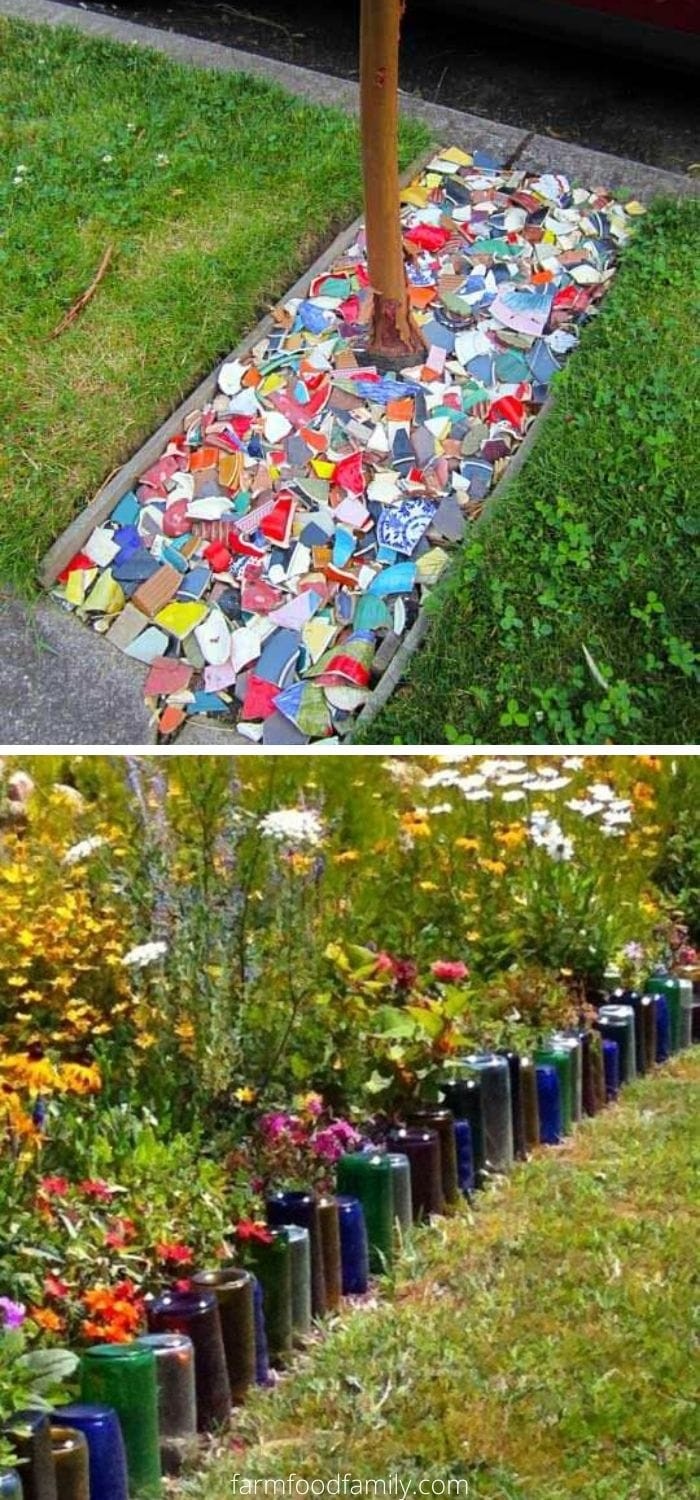
Transform your recycled garden edging with a vibrant mosaic using creative materials such as colored bottles, painted stones, and PET bottles. Arrange them in a visually appealing pattern to add a pop of color and personality to your outdoor space.
Scalloped garden edging

Scalloped borders may seem simple on their own, but they can add a touch of elegance to any garden design. Their wavy shape creates a visually appealing texture that can be used effectively in minimalist designs or even raised beds. For example, you could create a beautiful low-level bed inspired by the ones featured on Reddit in ‘Fantastic Viewpoint’ and ‘Crocus’, showcasing the beauty of nature with minimal fuss.
PVC garden edging
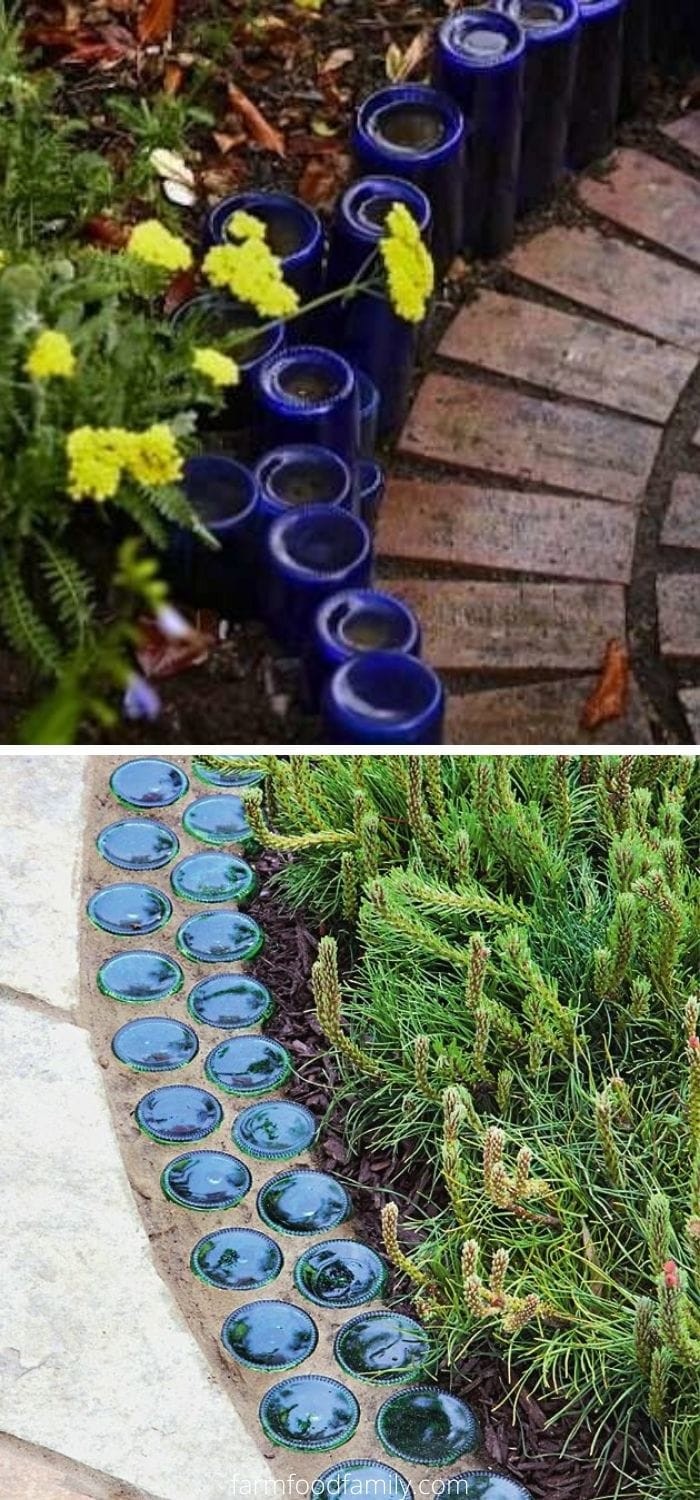
Innovative designs often blur the lines between categories, as is the case with this type of plastic garden edging. By repurposing old PVC pipes, you can create a unique and eco-friendly solution that not only reduces waste but also adds a touch of industrial chic to your garden. The possibilities are endless, with ideas including…
Victorian garden edging
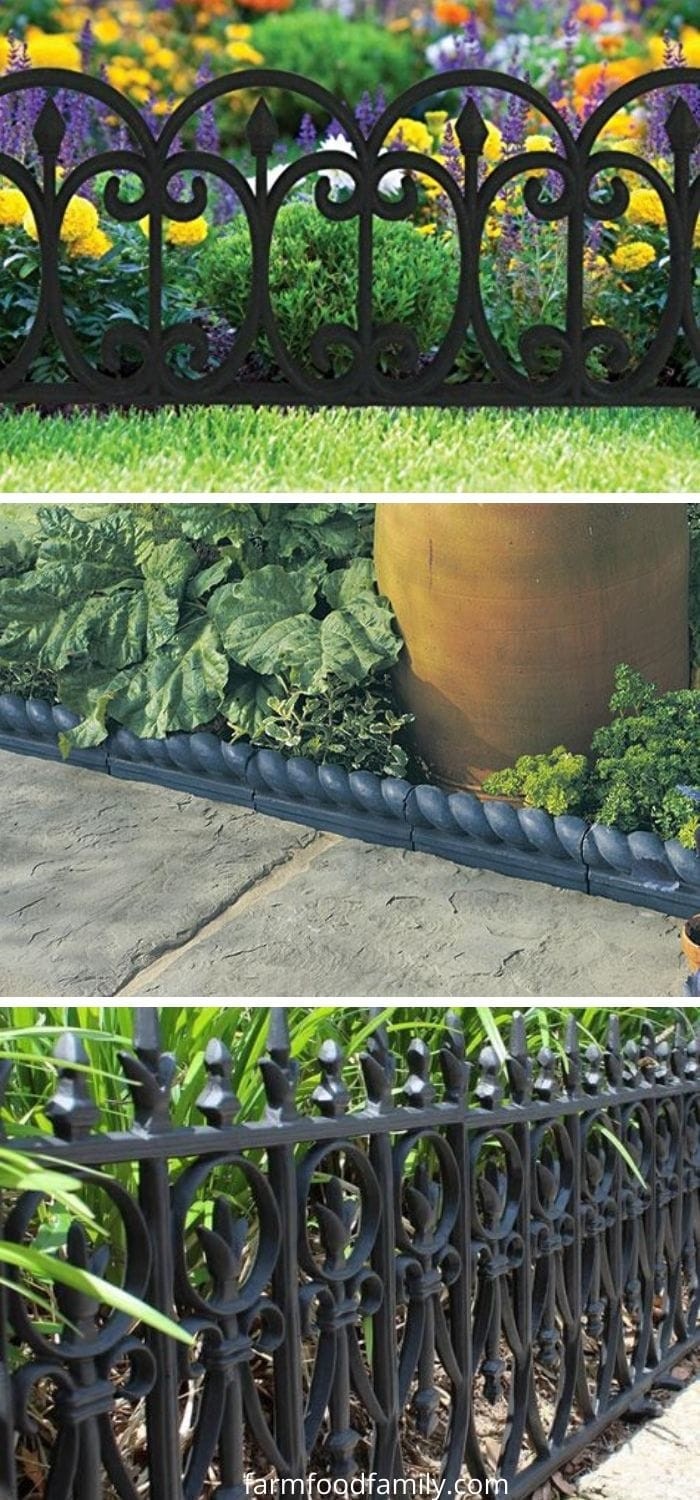
One of the defining characteristics of Victorian design is the incorporation of intricate designs and embellishments into concrete and metal structures. This can be seen in the ornate details that resemble knots, fleur de lis, and other decorative elements. Take a look at examples from Stone Market, Pinterest, and Albania Desert Cart to see these elaborate designs in action.
Cheap garden edging

For those who have been following along, it’s likely no surprise that the materials featured in this blog post tend to be budget-friendly. With that said, if you’re looking to create a beautiful and functional garden edging using recyclable bottles, plastic materials, old pipes, bamboo, pebbles, stones, or gravel, rest assured that doing so on your own is not only feasible but also extremely affordable.
If you’re interested in exploring more ideas for cheap garden edging, we’ve got some additional suggestions to share.
Garden Edging With Slate Chippings
Wood log garden-edging
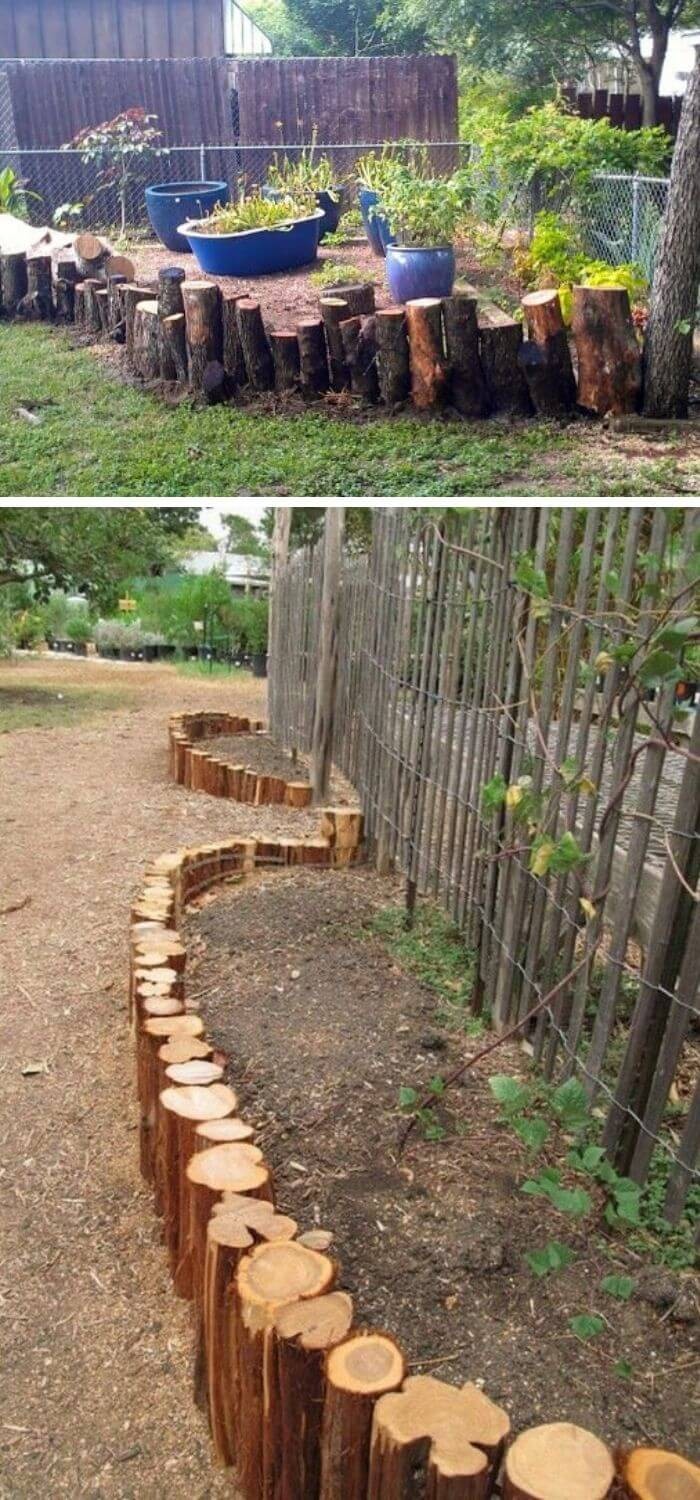
Transforming an ordinary outdoor space into a charming haven is just a few wooden logs away. The concept of wood log garden edging is simple yet effective: gather numerous logs, thoughtfully arrange them to create a unique border, and voilà! You’ll have a picturesque garden oasis nestled within the confines of your design.
China plate dish Garden edging

While your old plates may have served their purpose, they still hold value in creating a unique and charming garden edge. The innovative idea showcased on the source website (https://33barefootlane.wordpress.com/2010/04/10/china-plate-garden-border/) offers a creative way to repurpose these plates. Simply follow the steps outlined on the link and use it as one of your holiday assignments.
Straw bale garden edging
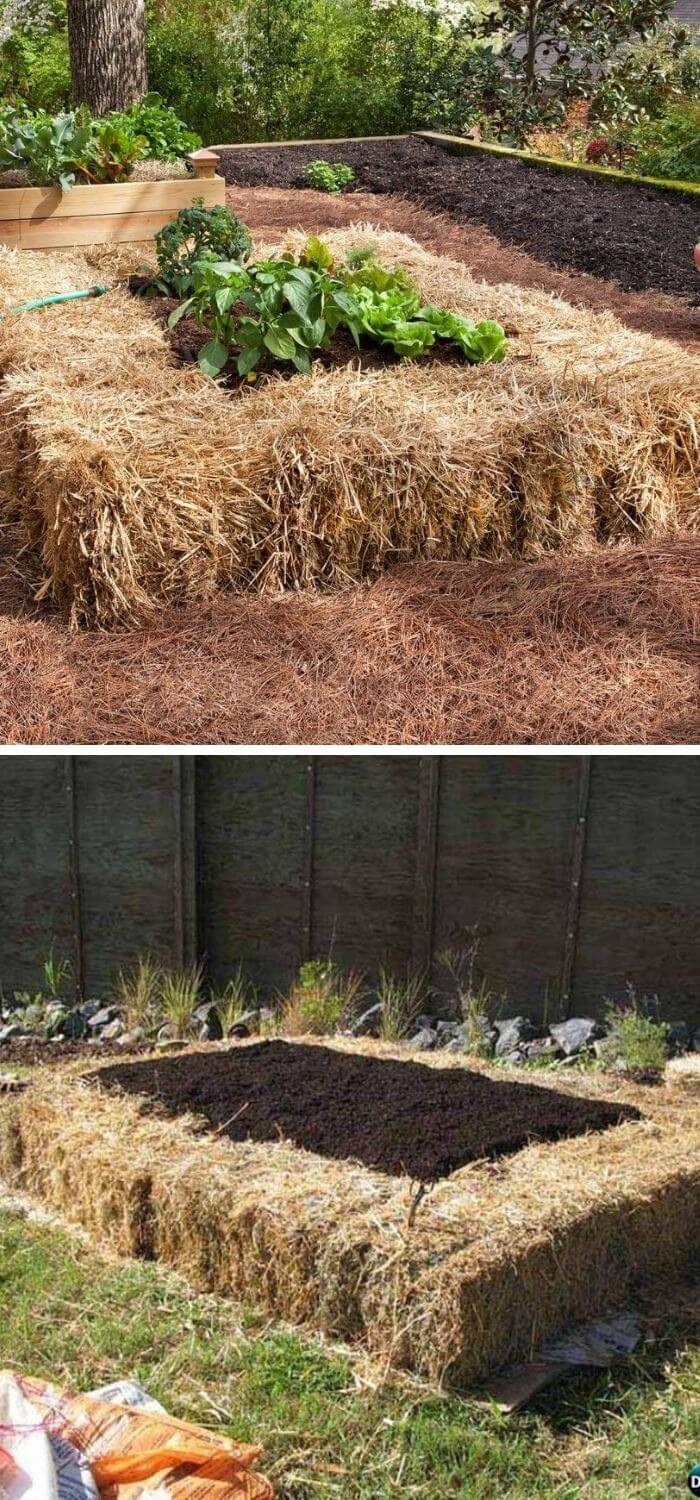
For individuals with ample straw bale supplies, this approach offers endless possibilities. By creatively arranging the bales, you can craft a picturesque garden edge perfect for planting an array of colorful flowers and other thriving vegetation. The provided link serves as a comprehensive guide, outlining each step necessary to bring your vision to life.
Steel garden edging
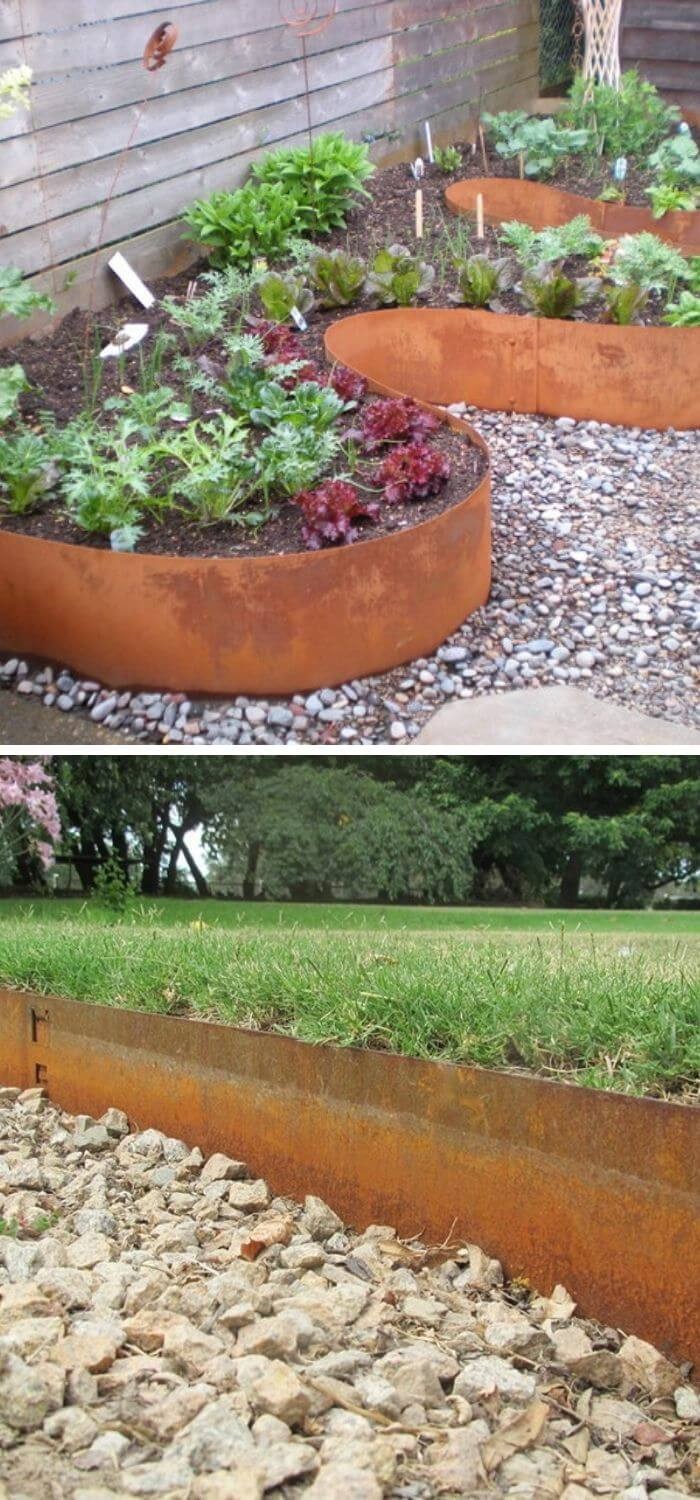
If you’re looking for a unique and creative way to enhance your garden, consider incorporating steel garden edging into your design. With these steps, you can create an eye-catching feature that will surely impress your visitors and bring a fresh perspective to your outdoor space.
Living tree plant garden edging
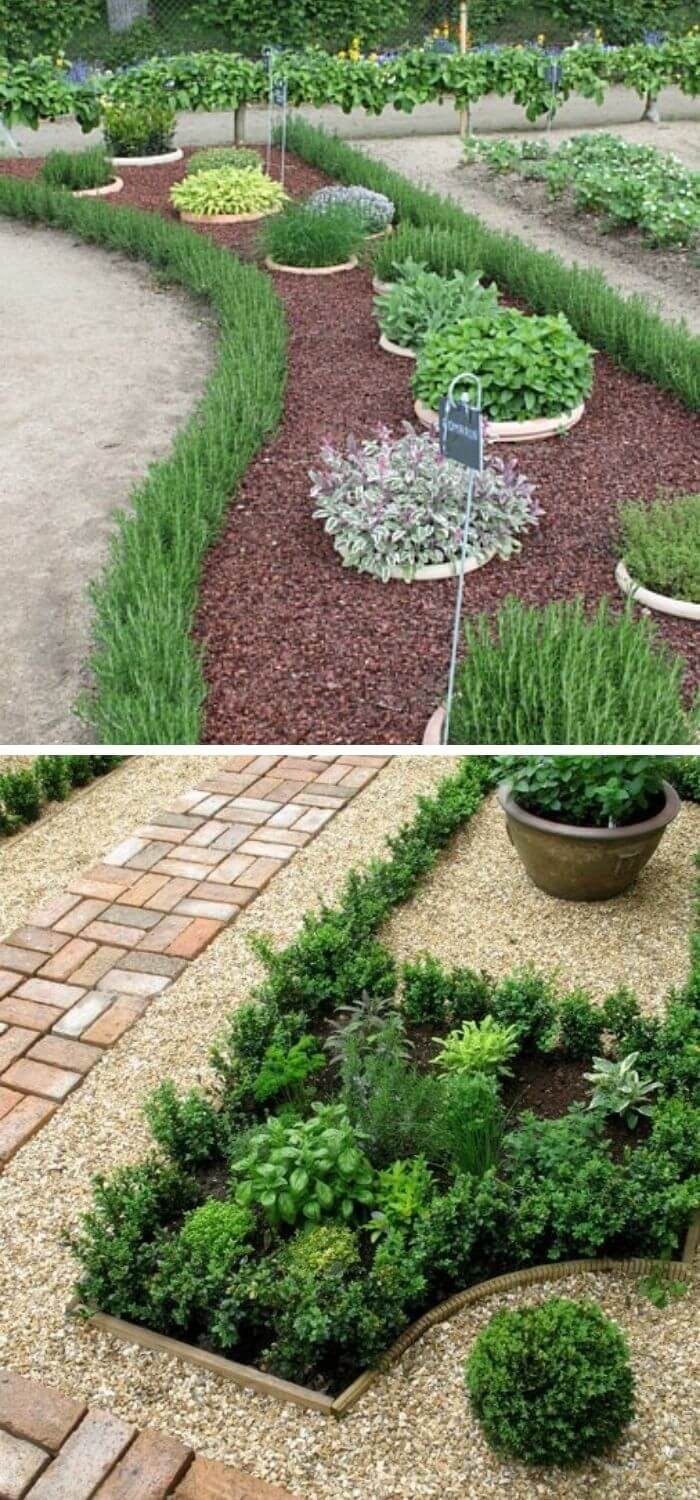
When it comes to gardening, incorporating trees into your landscape design can be a thoughtful and eco-friendly approach. By planting numerous trees along garden edges, you not only demonstrate your dedication to environmental stewardship but also showcase your passion for nature’s beauty. This unique idea not only adds a touch of elegance to your outdoor space but also provides a sense of responsibility towards preserving the natural world.
Old metal wheels’ idea
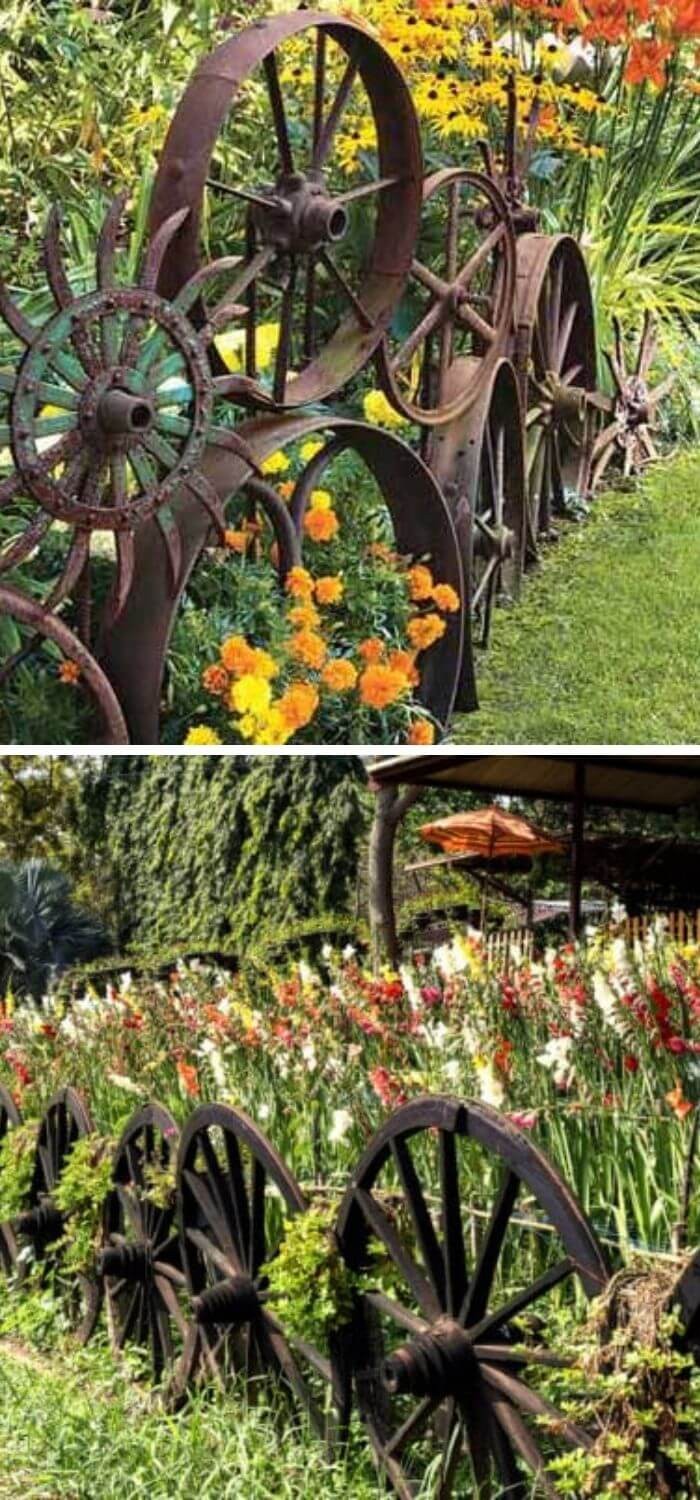
For garden enthusiasts who have access to metal wheels, an old metal wheels’ idea can be a fantastic and resourceful edging solution. If you don’t have the necessary materials readily available, consider purchasing them from a craft store or scouring local thrift shops for the perfect pieces to repurpose.
Bike wheel garden edging
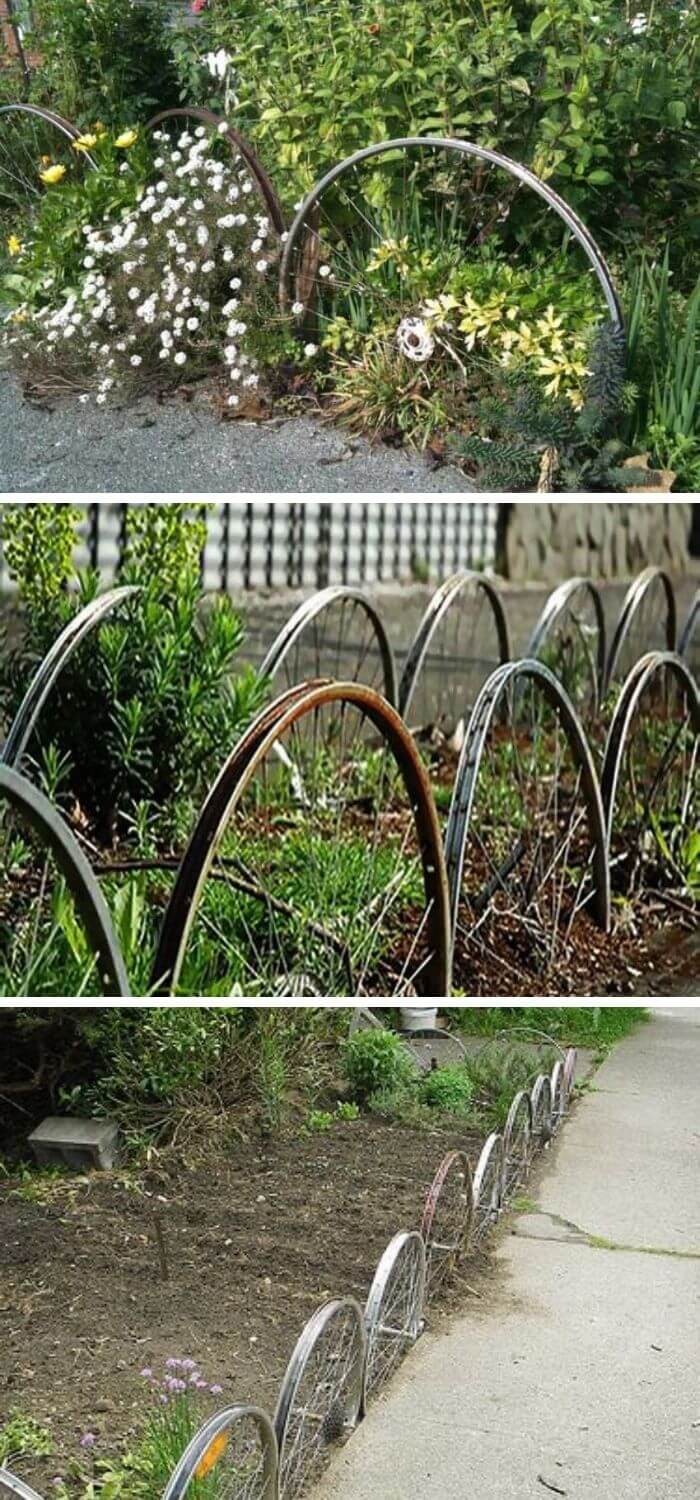
For those with a collection of vintage bicycles, transforming old bike wheels into garden edging can be an innovative and visually striking project. To get started, seek inspiration from online sources and explore the steps required to bring this creative concept to life.
Paint pallet garden edging

Transforming your outdoor space with paint pallet garden edging has become an increasingly popular trend among gardening enthusiasts. This creative approach not only adds a pop of color to your landscape but also repurposes discarded materials into something truly unique and beautiful. By painting the pallets, you can further enhance their aesthetic appeal, making them a standout feature in your yard.
Rock stone edging
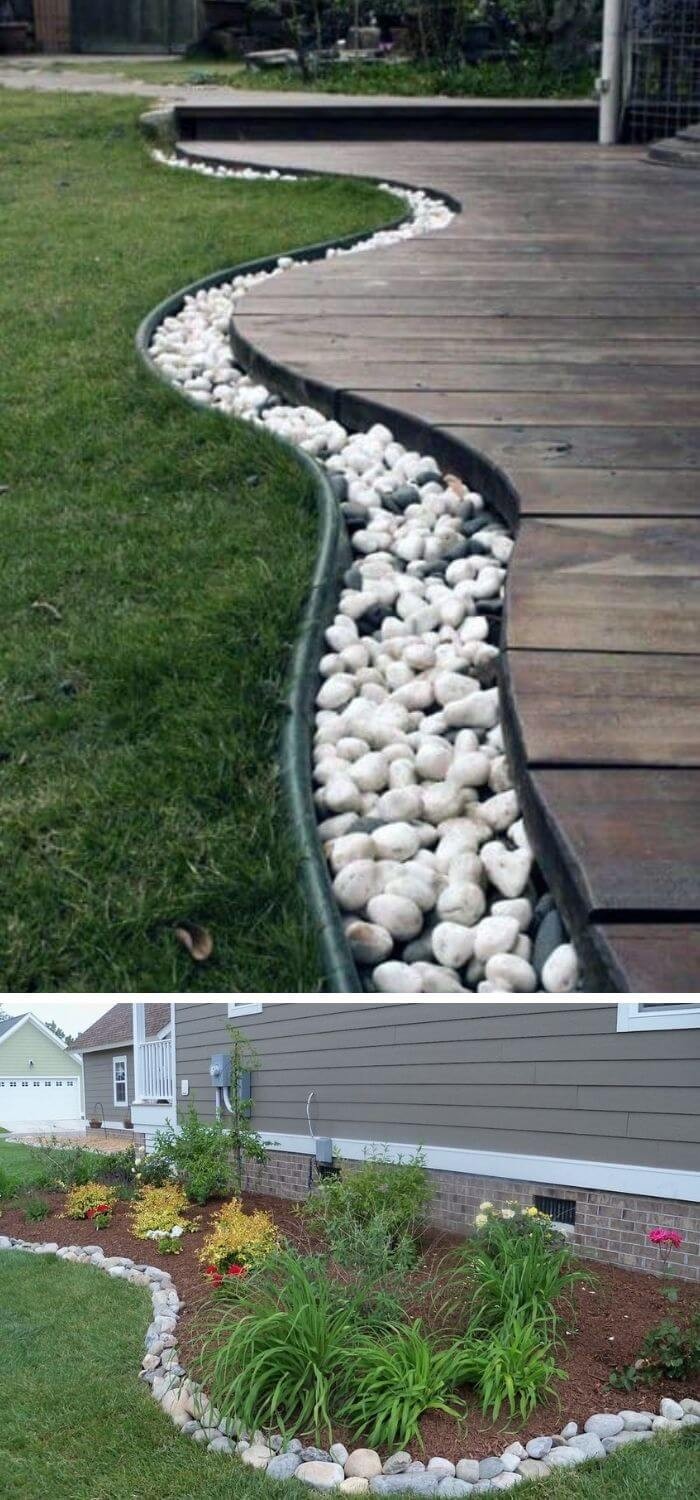
While stones may often be overlooked, they can add a touch of elegance to your outdoor space when used creatively in gardening. The beauty of painted stones is that they can be customized to match your home’s unique style and theme. When it comes to using stones around your home, there are many creative ways to make the most of this natural resource.
Pipe tuber border garden

For garden enthusiasts looking to add a unique touch to their outdoor space, consider creating a stunning pipe tuber border garden. This innovative idea allows for endless creativity and experimentation. To get started, simply follow the step-by-step instructions on how to create this beautiful border. With a little imagination and some basic materials, you can transform your garden into a one-of-a-kind masterpiece. Check out the inspiration behind this project at http://floradoragardens.
blogspot. com/2011/11/meadow-creek-house-seattle. html for more information.
Stone bricks garden edging
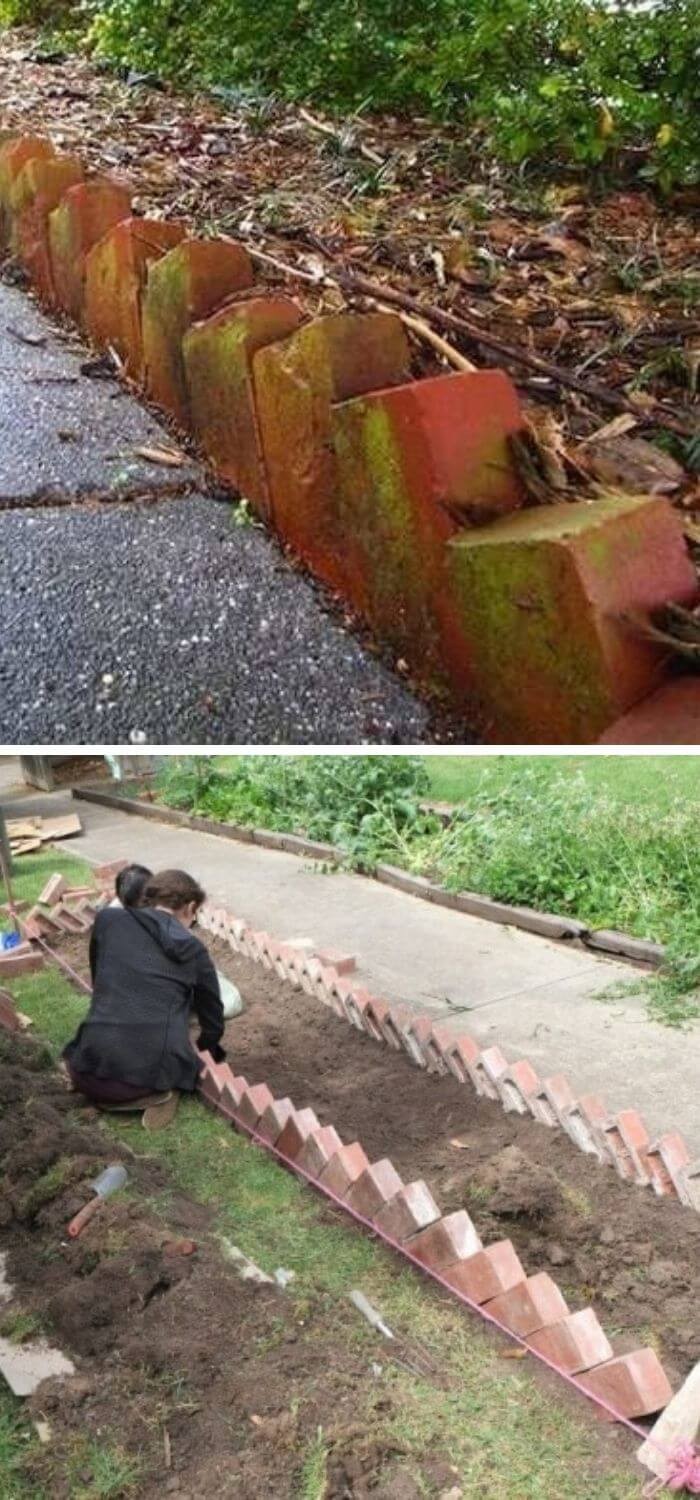
When it comes to repurposing materials from a building project, one of the most effective and aesthetically pleasing solutions is using stone bricks for your garden edging. Not only does this idea offer a creative way to reuse leftover brick remnants, but it also adds a touch of elegance and sophistication to your outdoor space. Imagine having a beautifully manicured lawn, with neatly arranged stone bricks defining the borders and adding a pop of color and texture.
This unique approach will not only enhance the curb appeal of your home but also provide a beautiful focal point for your garden.
Scrap wood garden bed edging

As you endeavour to create a unique and innovative garden bed edging, consider embracing the scrap wood approach. This creative solution not only saves resources but also adds an element of rustic charm to your outdoor space. To ensure a seamless process, we’ve compiled a comprehensive guide that takes you through each step, from preparation to completion. With this tried-and-true method, you’ll be ahead of the curve in terms of garden edging ideas, and your neighbours will surely take notice.
White Gabion raised garden bed border
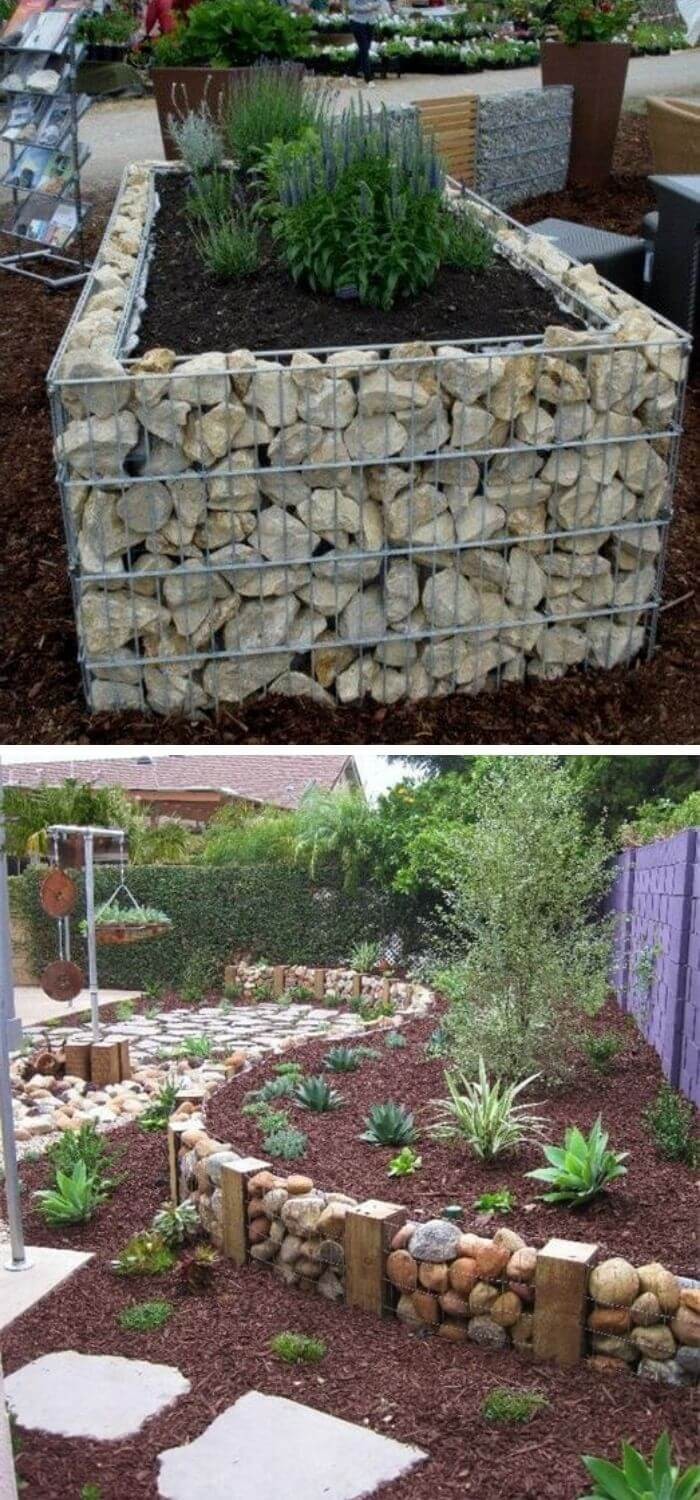
Creating gabions for your garden bed edges is a straightforward process that requires minimal expertise, making it an accessible project for anyone. By drawing inspiration from creative designs and ideas, you can easily bring this concept to life.
Terracotta pipes garden edging
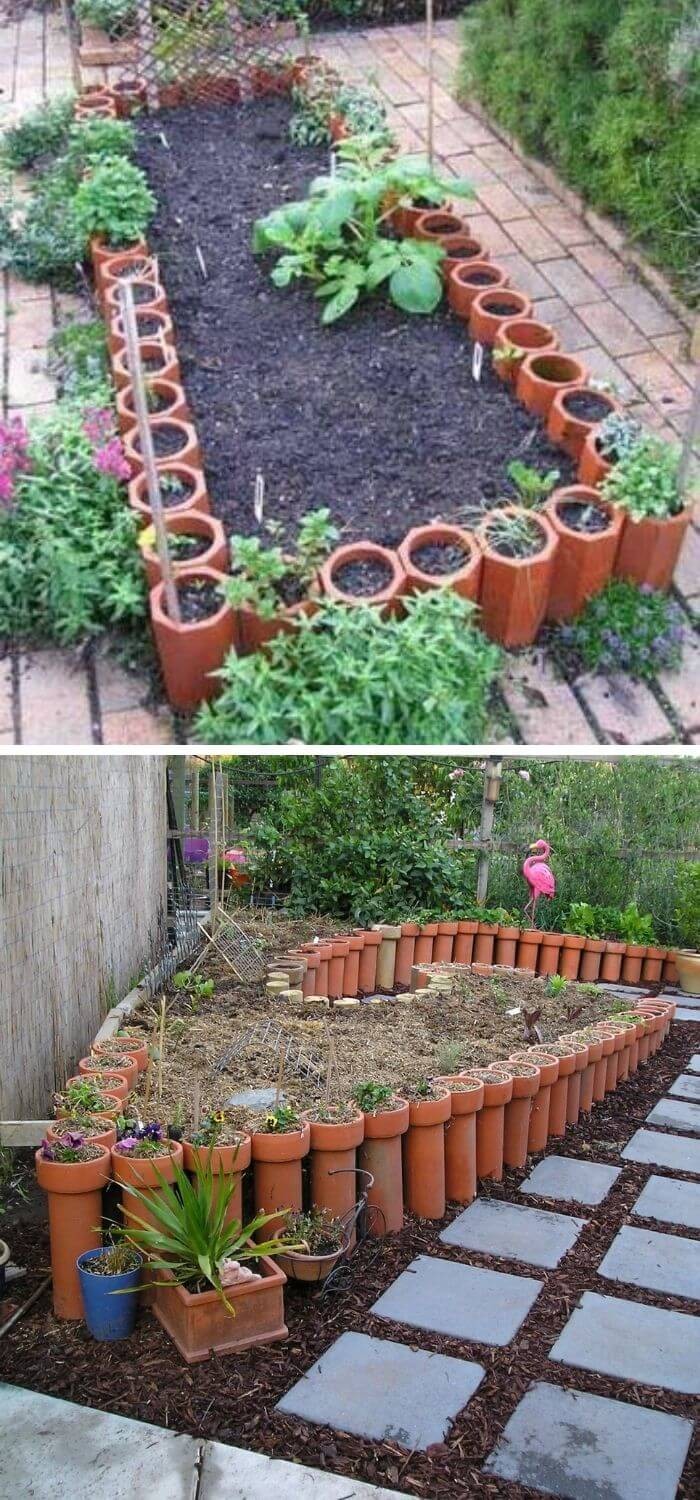
Drawing inspiration from a creative source, why not embark on an innovative terracotta pipe garden edging project? If you don’t have access to these pipes, fret not – they’re readily available at craft stores for a reasonable price. Transform your outdoor space into a charming haven that brings joy and serenity, serving as a constant reminder of the importance of nurturing happiness.
Cinder block edging

For a low-maintenance and visually appealing garden edging solution, consider cinder block edging. This creative approach requires minimal effort and provides a charming finish. To get started, explore the comprehensive guide at [http://www.abbisiler.com/crafts/my-happy-little-garden](http://www.abbisiler.com/crafts/my-happy-little-garden) for step-by-step instructions and inspiration.
Conclusion
Garden edging is more than just a physical barrier or divider. It’s about creating harmony and balance in your outdoor space by thoughtfully placing complementary elements together. By grouping similar features or highlighting specific areas, you can create a sense of cohesion and visual interest. Ultimately, garden edging helps to organize and personalize your yard or garden, making it a true reflection of your creativity and hard work.


